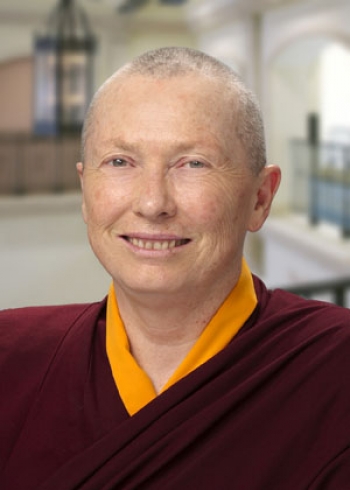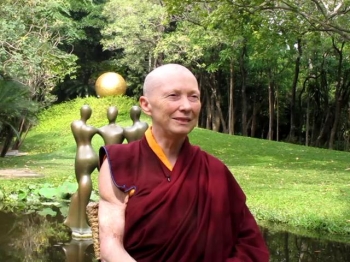Ven. Karma Lekshe Tsomo is the Branch and Chapter Coordinator of Sakyadhita International Association of Buddhist Women. In this series of seven questions we presented to her, she reflects on some key issues about Buddhist women and the long road ahead.
KLT: Change is gradually happening, but Buddhist institutes are still run almost run exclusively by men. As an ancient tradition struggling to survive under very different social conditions and faced by intensive conversion attempts in many countries, Buddhism needs to utilize all of its human resources, especially women. Overall, women have proven themselves to be competent, honest, and enthusiastic about preserving Buddhist traditions, though their contributions have rarely been acknowledged.
For meeting the challenges of modern society, fresh ideas and new voices are essential. Women in traditionally Buddhist societies are very devout, hardworking, and dedicated to the Dharma. They need greater access to systematic Buddhist education to prepare them for more active and visible roles. When we look at women's achievements in education, law, medicine, business, and other fields, we see that women have the potential to excel in every field. Only in the fields of religion and politics are women being held back, and human society is the poorer for it. Buddhists who truly care about social transformation and spiritual development can no longer ignore women's potential to contribute greatly to the flourishing of the Dharma.
Great changes are afoot. Progress has occurred very swiftly in Sri Lanka, thanks to the supportive attitudes of a few monks. This has allowed Sri Lankan women to move ahead in the directions of intensive meditation practice and full ordination. Progress is also occurring in the Tibetan tradition, primarily in the field of education. There has been no progress in the direction of full ordination, but nuns are gaining confidence and are beginning to find their voice. In other countries, however, especially Laos and Cambodia, Buddhist women have made little progress, primarily due to political circumstances and poverty.
I believe there's a great need to develop a global perspective that understands the needs, challenges, and special abilities of Buddhist nuns in different societies. If Buddhists in more affluent countries understand the serious problems that Buddhists in less fortunate countries face, hopefully they will generate compassion and find ways to help their Buddhist sisters and brothers, especially sisters. When Buddhists from affluent countries go on pilgrimages, they donate generously to monks and monks’ projects, but rarely do they visit or even know about or care about Buddhist women’s projects. The image of the saffron-robed monk has a very powerful allure in the minds of most Buddhists. This image is almost always male and, as a result, financial support and encouragement flow almost exclusively to male monastics. With such unequal support for monks and nuns, the disparities between the circumstances of male and female monastics grows increasingly acute with each passing year. In fact, monks’ monasteries with lavish support have seen a decline in ethical standards, which has caused considerable disillusionment in the lay Buddhist community. So, ironically, the generous support that many lay Buddhists give has in some cases contributed to corruption in the sangha and has also exacerbated gender disparities. In secular society throughout the world, gender equity is the buzzword. But in Buddhist circles, conference speakers and institutional heads remain almost exclusively male. This syndrome works to disadvantage women. In view of the current global ethic of gender equality, some Buddhist societies appear extremely backward. We find a great contrast between Taiwan, Korea, Vietnam and increasingly China, where Buddhist nuns enjoy educational opportunities and strong lay support, and poorer countries without full ordination, where women are making very little progress. The contrast appears to turn on access to full ordination for women.
















